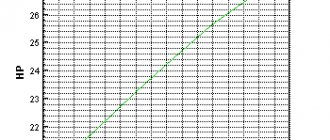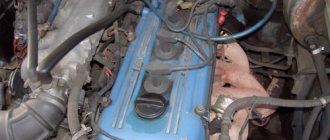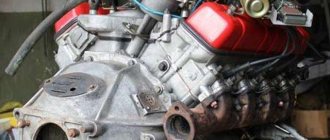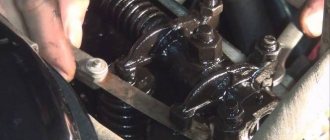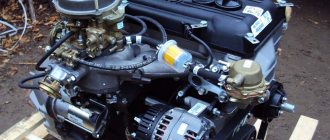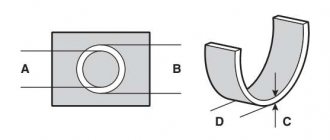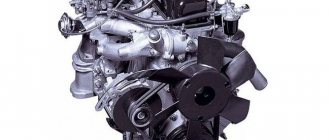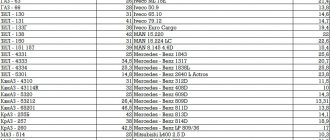The 4HG1 engine is positioned, that is, a power unit capable of running about 1,000,000 km before overhaul. The engine was created primarily for HQR71 series trucks with a gross weight of 8 tons. In addition, it is used in Bogdan buses and Isuzu Elf light-duty trucks.
ICE 4HG1
Isuzu designers used original solutions in the 4HG1 engine to provide torque of 153 Nm and power of 121 hp:
- in-line engine diagram with timing gear drive;
- overhead single camshaft controlling 4 intake and 4 exhaust valves via rocker arms.
Cylinder head 4HG1
Trucks are produced in Japan and at the Ulyanovsk Automobile Plant, part of the Sollers association. Unlike passenger cars of classes A - D, the owner is not faced with the task of increasing power after purchase. Much more important is the payback period and, accordingly, the resource and operating budget.
For the 4HG1 diesel engine, the modernization of its design made it possible to provide a service life of 1 million km. Initially, the management of the Japanese manufacturer provided for even such little things as the cost of the gear drive:
- if the timing gear, oil pump and cylinder liner wear out, these parts do not have to be replaced entirely;
- The manufacturer Isuzu produces bushings in several repair sizes that can be pressed in and bored on a machine.
Diesel injection pump 4HG1
This ensures the preservation of the operating parameters of the internal combustion engine and reduces maintenance costs.
You can study the technical characteristics of 4HG1 in the table below:
| Manufacturer | Isuzu |
| Engine brand | 4HG1 |
| Years of production | 2008 – … |
| Volume | 4570 cm3 (4.6 l) |
| Power | 83 kW (121 hp) |
| Torque moment | 322 Nm (at 4200 rpm) |
| Weight | 377 kg |
| Compression ratio | 19 |
| Nutrition | injector |
| Motor type | in-line diesel |
| Ignition | DIS-2 |
| Number of cylinders | 4 |
| Location of the first cylinder | TVE |
| Number of valves on each cylinder | 2 |
| Cylinder head material | cast iron |
| Intake manifold | duralumin |
| An exhaust manifold | cast iron |
| Camshaft | carbon steel, SOHC design |
| Cylinder block material | cast iron |
| Cylinder diameter | 115 mm |
| Pistons | cast aluminum |
| Crankshaft | steel 5 support, 8 counterweights |
| Piston stroke | 110 mm |
| Fuel | AI-92 |
| Environmental standards | Euro 2 |
| Fuel consumption | highway – 22.5 l/100 km combined cycle 24.3 l/100 km city – 26.5 l/100 km |
| Oil consumption | 0.6 l/1000 km |
| What kind of oil to pour into the engine by viscosity | 5W30, 5W40, 0W30, 0W40 |
| Which engine oil is best by manufacturer | Liqui Moly, LukOil, Rosneft |
| Oil for 4HG1 according to composition | synthetic in winter, semi-synthetic in summer |
| Engine oil volume | 10 l when replacing filter |
| Operating temperature | 95° |
| ICE resource | declared 450,000 km actual 1,000,000 km |
| Adjustment of valves | hydraulic compensators |
| Cooling system | forced, antifreeze |
| Coolant volume | 18 l |
| water pump | built-in |
| Spark plugs for 4HG1 | NGK 32A6607200 |
| Spark plug gap | 1.1 mm |
| Timing drive | gear |
| Cylinder operating order | 1-3-4-2 |
| Air filter | VIC A-522V, Top Fils A-519/A-510 |
| Oil filter | SK815, Asakashi C518J, Xauto LC711, Union C7111 |
| Flywheel | 8-97209-844-3 350 mm, 8 holes |
| Flywheel mounting bolts | M12x1.25 mm, length 26 mm |
| Valve stem seals | manufacturer Goetze, inlet light, exhaust dark |
| Compression | from 13 bar, difference in adjacent cylinders maximum 1 bar |
| XX speed | 750 – 800 min-1 |
| Tightening force of threaded connections | spark plug – 25 Nm, flywheel – 78 Nm + 90° – 120° clutch bolt – 96 Nm bearing cap – 98 Nm, 132 Nm + 30° – 60° (main) and 83 Nm (connecting rod) cylinder head – three stages 98 Nm, 147 Nm + 30° – 60° |
The user manual contains a description of the design and step-by-step steps for servicing the diesel engine.
Design Features
The 4HG1 naturally aspirated in-line diesel engine has the following architectural features:
- cylinder block - cast iron with dry repairable liners made of alloy steel, frame housing, 5 crankshaft supports, steel vibration damper pan;
- cylinder head - cast iron with increased valve diameter, cross-blow, aluminum cover, laminated steel gasket using advanced technology;
- ShPG - the piston has a special shape for rapid heat dissipation, the pin is offset to reduce noise and torsional vibrations, axial type seals on the crankshaft;
- mounted – high-resource, rationally distributed under the hood;
- oil pump - partially built into the cylinder block, only the top cover is removable;
- Timing – camshaft made of carbon steel, bearing surfaces are hardened by high-frequency current, timing gears and attachments are forged, installed with interference fit;
- Fuel injection pump is a multi-row plunger with a timer.
Cylinder block 4HG1
Crankshaft 4HG1
The combustion chambers are undivided; liquid gaskets are used for the pump, oil cooler, crankshaft housing and crankcase.
An important feature of the 4HG1 diesel engine is the use of an intake manifold made of composite material with the inclusion of noise-absorbing rubber. The exhaust manifold is cast iron, the exhaust volumes are calculated and do not create back pressure.
The design of the diesel engine does not have complex components and parts; major repairs can be carried out both in the garage and in the field.
List of internal combustion engine modifications
The naturally-aspirated diesel engine 4HG1 from Isuzu has a Turbo modification 4HG1-T with the following characteristics:
- power – 121 hp;
- torque - 322 Nm;
- compression ratio – 19;
- environmental standards – Euro-2;
- consumption in the urban cycle is about 20 liters.
Modification 4HG1-T
The diesel engine is equipped with a Turbocharger 704136-0003 turbocharger with a GT3076R kit and an intercooler.
Advantages and disadvantages
The simple design of the internal combustion engine ensures driving dynamics at any speed. The motor is a “millionaire”, which is proven by real operating experience. Fuel and oil consumption is moderate, maintainability is high, including by the owner’s own efforts.
Hydraulic pushers are responsible for adjusting the thermal clearances of the valves, so the user does not need to go to the service technician after 30 thousand miles. Gear transmission is much more reliable than belt and chain and provides maximum valve safety.
Timing gear
On the other hand, after 70 - 80 thousand km, the hydraulic pushers begin to ring, and they need to be replaced. Diesel is sensitive to the quality of diesel fuel, in which in the Russian Federation the content of paraffin and sulfur is too high, which worsens the winter start-up and reduces the service life of the ShPG, accordingly.
Conclusions - what is worth knowing about motors from Koreans?
These engines are difficult to replace with others. Therefore, in the event of a total failure, you can look for contract options. There are many offers on the market from Asia with relatively low mileage. There is no point in repairing an engine with a mileage of 180-200 thousand km; its service life can already be considered complete.
The engine on the Getz is worse than on the Picanto and i10. The machine is heavier and requires more power for normal daily use. If the question is about replacing the engine with a Getz, it is better to buy a more powerful modification and make a swap.
List of car models in which it was installed
The 4HG1 motor powers the vehicles:
- Isuzu Elf – truck 2 – 3.5 tons;
- Isuzu NQR71 – 5.5 t 4x2 truck;
- Bogdan - city bus A092.02 and school bus A092S.
Isuzu NQR71
The above engine characteristics ensure long-term operation in harsh conditions.
Maintenance schedule 4HG1 4.6 l/121 l. With.
The official manual of the Japanese manufacturer Isuzu recommends servicing the 4HG1 engine within the following periods:
- Do-it-yourself filling of new oil is carried out every 10,000 km;
- Attachments should be checked annually;
- The service life of the battery is set by the manufacturer of the battery, not the engine, usually 5 years or 45 thousand km;
- factory experts advise changing antifreeze after 50,000 mileage;
- It is recommended to throw away the fuel filter after 30,000 km, use a new air filter cartridge after 20,000 km;
- the exhaust manifold of engines usually burns out after 70 thousand mileage;
- the crankcase ventilation system needs to be cleaned after 30 thousand km;
- Thermal valve clearances are adjusted annually or every 30,000 km.
Adjustment of valves
The boosting of the diesel engine is the reason for the mandatory reduction of intervals between maintenance services by at least 30%. After increasing the power of the internal combustion engine, overhauls will be required more often.
Advantages of small units from Korea
South Korean manufacturers have created good engines. The younger one can be repaired; the cast iron block allows this to be done. But the small volume makes a major overhaul not the best idea.
The absence of hydraulic compensators has become an advantage, as the cost of engine maintenance and repair has decreased. It is enough to adjust the valves once every 30-40 thousand km.
The advantages include the following parameters:
- very low fuel consumption, the parameter declared at the factory is comparable to reality;
- quite adequate work in tandem with both mechanics and automatic transmission;
- elastic operation throughout the entire speed range, excellent dynamics, as for its power;
- cheap maintenance, no need to buy expensive spare parts and accessories;
- A service life of about 200,000 km is considered quite good in this family of engines.
The most simple design was the task of Korean brands, and this became a big advantage of the power units of the KIA and Hyundai concerns. Today, motors are already outliving their useful life and need to be replaced, since raising their environmental standards to Euro 6 is only possible using unsightly methods.
Review of faults and methods for repairing them
Thanks to the gear drive, the 4HG1 motor never bends the valve, but has some characteristic malfunctions:
| Heavy oil leak | 1) depressurization of the neck plug 2) destruction of the cylinder head cover seal 3) wear of the fuel pump gasket | 1) replacing the plug 2) replacing the valve cover gasket 3) replacing the fuel injection pump gasket |
| Smooth but unreasonable decrease in lubrication level | 1) loosening the camshaft plug 2) the plug thread is broken 3) crankcase ventilation is clogged 4) development of the rear oil seal 5) weakening the oil filter | 1) pulling bolts 2) replacing the plug 3) cleaning the crankcase ventilation 4) replacing the oil seal 5) replacing the gasket and tightening the filter with a special tool |
| Noise inside the timing belt | 1) leakage in hydraulic compensators 2) wear of the roller or rocker arm 3) rod deformation 4) low lubrication level | 1) replacement of hydraulic pushers 2) replacing the roller and rocker arm 3) replacement of rods 4) topping up engine oil |
Repair 4HG1
The power drive was originally created for harsh operating conditions, therefore, with a service life of one million hours, it is highly reliable and does not cause problems for the user.
Engine G4HG
As for the shortcomings, the engines that were produced before 2009 had a serious defect in the gas distribution mechanism drive. As a result, the valves would meet, leading to costly repairs.
Our main character is very afraid of high work temperatures. Therefore, its driver needs to carefully monitor the cleanliness of the radiator honeycombs, and also often add coolant to the car’s radiator. Another serious weakness noted by thousands of drivers is spark plugs. They need to be changed every 15-17 thousand km. Otherwise, the car's electronic control unit will bombard the driver with errors.
According to the regulations for the operation of this internal combustion engine, the timing belt must be replaced once every 90,000 km. However, it breaks much earlier. That is why we advise you to pay attention to it every 40-50 thousand km. If the car is used in urban conditions, or will be subject to serious loads, then it is necessary not to pay attention every 30 thousand km.
Problems also include problems with the air flow sensor. The symptoms are similar to generally consistent with low compression or low vacuum. Also symptoms similar to when your car has low fuel pressure from a faulty fuel pump. Here are some of the most common symptoms of a faulty mass air flow sensor:
- The engine is very difficult to start
- The engine stalls shortly after starting
- Engine hesitates or drags under load or at idle
- Oscillations and jerking during acceleration
- Engine hiccups
- Excessively rich or lean idle
If you think your vehicle's air flow sensor is faulty, take it to a qualified mechanic to perform a full computer diagnostic. In most cases, a faulty mass flow sensor has a special code that is generated during computer diagnostics and is usually easy to identify using computer test equipment.
As a general rule, you need to clean your air flow sensor every six months or every time you change the oil. Cleaning it when replacing or cleaning the air filter will be a good way to save time and money.
Remove the Sensor To clean the MAF sensor, you must first remove it. This can be done by opening your car's air box and using a flat head screwdriver to pull it out. When removing the sensor, be sure not to touch the wires. A disconnected MAF sensor may not cause an electrical shock, but the wires are thin and small.
Clean the sensor Next, you have two options. The cheapest option is to take the MAF sensor and place it in a plastic bag filled with alcohol. Another option is to go to your local auto parts store and buy a special MAF sensor cleaner and spray it on your sensor, but as stated earlier, this is more expensive.
Dry and reinstall the sensor. After cleaning the MAF sensor with cleaner or alcohol, let it sit, usually for 20 minutes or more. The sensor must be completely dry before it can be installed in the vehicle, otherwise you may damage it.

